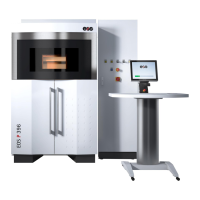Basic information on materials
4.1
Training manual • Basic training • Status 03.14
EOS P 396
4
Basic information on materials
Material types
All EOS plastic powders are listed with a description of the properties and the
application areas in the PDF file EOS_Materials_Broschure_Table_en.pdf on the EOS
homepage at http://www.eos.info/material-p.
Pay attention here as to whether the related material can be processed on the
machine.
☞ Material - machine compatibility.
Powder states
In principle a differentiation can be made between five different powder states:
➢ New powder
Plastic powder from the original container or powder from the powder supply
bins that has not yet been processed.
➢ Used powder
Plastic powder from the exchangeable frame or from the collector bins that must
be sieved and refreshed prior to further use.
➢ Used powder, sieved (recycled powder)
➢ Refreshed powder
Mixture of sieved used powder (recycled powder) and new powder.
➢ Waste
Residue from the sieve or plastic powder that has already been removed on
unpacking the parts.
Damage to the powder during the building process
During the building process the plastic powder is damaged by two effects:
➢ Baking of the powder grains
During the building process the plastic powder tends to bake together with other
grains in the immediate area around the parts and in the zones with a higher
temperature. These grains must be sieved out prior to the reuse of the plastic
powder to avoid problems during the building process.
➢ Chemical change in the plastic powder due to the effect of heat
Due to the high temperature during the building process over an extended period,
the plastic powder is subjected to an ageing process. This ageing process is not
reversible such that the plastic powder is permanently damaged. The damage/
ageing has a negative effect on the building process and on the quality of the

